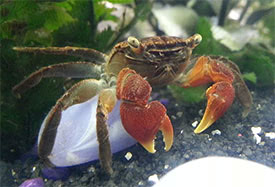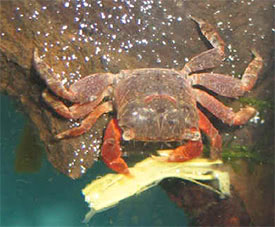
 Magyarul / Hungarian
Magyarul / Hungarian




- Scientific name: Perisesarma bidens
- Synonyms: Grapsus bidens, Sesarma bidens, Chiromantes bidens
- Common name: Red Claw Crab, Red Crab, Thai Crab
- Group: Freshwater invertebrates
- Habitat: Southeast Asia; Hong-Kong, Thailand, Singapure
- Size: 5 cm
- Biotope: Found in mangrove swamps along the shores, or on mudflats.
- Social behavior: Males can be territorial with each other. Can be kept with other crabs, but fights may occur, especially when they are kept in a too small tank. They can also predate small or slow moving fish. It is best kept in a species-only tank.
- Diet: Omnivorous; unfussy eater, they are opportunistic scavengers in the wild, and will readily accept any live and dried foods in the aquarium. They will also eat some algae or plant matter.
- Breeding: Rare in aquarium
- Tank: Minimum 40 litres
- Population: 1 male and 3-4 females for 40 litres
- Decoration: Best kept in brackish conditions with land access, or with an area above the water line, what can be mangrove roots, or rock structures. Use sand as substarte, so the crabs can burrow and hide into it. They will eat quatic plants. Their tank must be covered, as they are excellent climbers and great escape artists.
- Temperature: 24-27 °C
- pH: 7.5-8.5
- Hardness: 8-12 NK°
- Lifespan: 2-3 years
Description: Perisesarma bidens males have dull red body color with brown patterns and bright red claws. They have flattened shell with protruding eye stalks, and two equal sized claws. Females have darker, more brownish claws. On both sexes the tip of the pincer is a creamy yellow coloration. They use fine hairs on their legs and claws to taste the sand and will spend a lot of time scavenging the substrate for food. These crabs like to make small, tight fitting caves under rocks and mangrove roots with their claws, where they will quickly hide to safety when threatened. They also spend a few days in their burrows during molting and should not be disturbed during this process. The Red Claw Crab is a good climber and will go exploring outside of the tank if it finds a way out, so their aquarium must be covered. They will also climb on air tubes and power cords. Red crabs are particularly sensitive to copper, which is an ingredient in many fish-disease treatments and snail-eradication chemicals, so do not use these chemicals in their tank. They can survive in freshwater, however in order to thrive these crabs require brackish water, as they live in such conditions in their natural habitat. They usually more active during night.
Males are larger, and more brightly colored than females, and they also have bright red claws. The Red Clawed Crab has been bred in captivity, but it is rare as the larva of the crab live for a time as plankton in the water column, so most crabs for sale will be wild caught. The female Red Clawed Crab will carry her eggs under her wide tail for about three weeks. The eggs will be red at first and then slowly change color during the brooding, and when hatching is near they will turn grey. At this time the female should be placed in a separated breeding tank with similar water paramaters. Keep the female in there until the all the eggs have hatched. The larvae can be fed with newly hatched brine shrimp nauplii 3-5 times a day. These Red Clawed Crab larvae will moult approximately every third day, and many may die during this period. After a few weeks the surviving larvae will more look like tiny Red Clawed Crabs. They will not swim around as much in the watercolumn, instead they will walk on the sand or other surfaces. At this point they will moult about every 7th to 10th day, and they can be fed with flake foods. After a few months the crabs will probably be about 1 cm, when the sexes can be tell apart.




